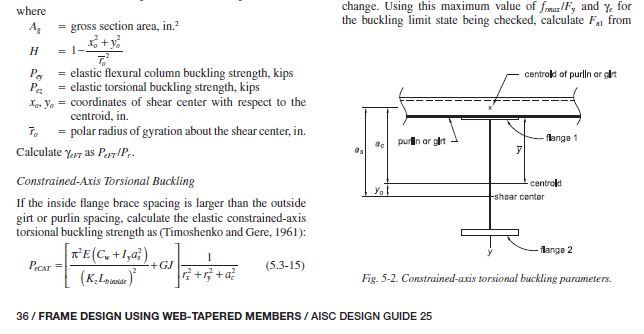NewEngineerHere
Structural
- May 29, 2015
- 15
Hi everyone:
I am a recent graduate and trying to understand the beam bracing analysis/design.
I read in many texts that the beam flange needs to be braced otherwise it would buckle ( like a wave shape as we see in a column under axial load.)
Now my questions are:
If I have a beam supporting floor slab, (top flange is fully braced- great, no worries) Now, bottom flange needs to braced so it does not rotate (torsional buckling?)
how do I know if I really need to brace or not ? OK, AISC manual gives a Cb equation I can calculate my un-braced length
1) How can I correlate Cb equation with the moment applied to the beam, or stability of the beam ? Cb should tell me how much more moment capacity I am gaining for providing that brace at that distance (correct?).... what does it have to do with stability ?
2) What If I have moment connection (double curvature moment diagram) is it different than simply supported ? ( Do I always need to brace both flanges Tension and compression ?
3) How much load will be brace see? how much should be designed for, is this load coming from the moment or out of plane load ( wind, seismic )?
4) When do I need to brace/add stiffener to the web of the beam ?
My first thoughts are: If the beam works for giving load for moment, shear, and deflect - perfect.....But know I have stability issues I need to understand.
I am just trying to make sense of equations, rules, and develop a sense of what is right and what is wrong (how can I prove by calculation).
Thank you
I am a recent graduate and trying to understand the beam bracing analysis/design.
I read in many texts that the beam flange needs to be braced otherwise it would buckle ( like a wave shape as we see in a column under axial load.)
Now my questions are:
If I have a beam supporting floor slab, (top flange is fully braced- great, no worries) Now, bottom flange needs to braced so it does not rotate (torsional buckling?)
how do I know if I really need to brace or not ? OK, AISC manual gives a Cb equation I can calculate my un-braced length
1) How can I correlate Cb equation with the moment applied to the beam, or stability of the beam ? Cb should tell me how much more moment capacity I am gaining for providing that brace at that distance (correct?).... what does it have to do with stability ?
2) What If I have moment connection (double curvature moment diagram) is it different than simply supported ? ( Do I always need to brace both flanges Tension and compression ?
3) How much load will be brace see? how much should be designed for, is this load coming from the moment or out of plane load ( wind, seismic )?
4) When do I need to brace/add stiffener to the web of the beam ?
My first thoughts are: If the beam works for giving load for moment, shear, and deflect - perfect.....But know I have stability issues I need to understand.
I am just trying to make sense of equations, rules, and develop a sense of what is right and what is wrong (how can I prove by calculation).
Thank you

